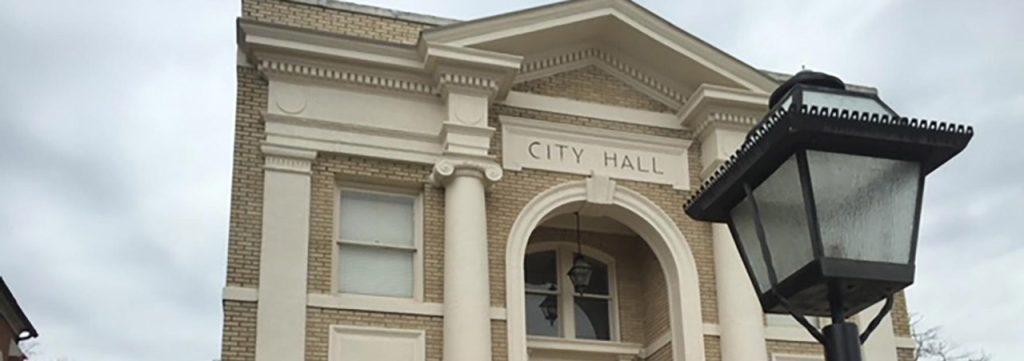“A Brief History of Holly Springs”
Holly Springs was founded by European-Americans in 1836, on territory historically occupied by Chickasaw Indians for centuries before the Indian Removal Act. It served as a trading center for the neighboring cotton plantations. It was originally called Suavatooky but in 1837 the city was incorporated and renamed Holly Springs and made the seat of government for the newly created Marshall County.
More and more white settlers came to this area when it was found that the soil was richly fertile and cotton became the cash crop with cultivation and harvest done largely by the slave population. The city became the center of antebellum culture in north Mississippi.
By 1855, Holly Springs was connected to Grand Junction, Tennessee, by the advancing Mississippi Central Railroad. When the line was completed to Holly Springs, cotton was easily shipped to market and the plantation economy grew richer. Toward the end of the century, the Kansas City, Memphis and Birmingham Railroad was constructed to intersect with this line.
During the Civil War, these railroad connections were increasingly important to both North and South. Union General Ulysses Grant used Holly Springs as a supply depot and headquarters. Confederate General Earl Van Dorn raided and burned much of Grant’s supplies in December 1862. As a consequence, much of the town and the Courthouse were burned by the Yankees.
In 1878, as the city was rebuilding its economy and society, the city suffered a yellow fever epidemic in which over 2,000 residents died. The existing county Courthouse, at the center of Holly Springs was used as a hospital during the epidemic.
Holly Springs is fortunate in having an Audubon Sanctuary which is located 3 miles north of the town where an annual Hummingbird Migration Celebration is held in early in September. For additional information, you may call 662-252-1155, the Strawberry Plains Audubon Center.
Come Visit Holly Springs!


History Timeline
This area was home to the Chickasaw Indians. During the early 1700s, white settlers moved to the Mississippi area in search of rich soil for farms and plantations. In 1736, the Chickasaw helped British soldiers to defeat the French who were attacking the Indians for raiding French settlers in southern Mississippi. This led north Mississippi to become involved in the French and Indian War. The Treaty of Paris, signed to end the War, gave England all the land east of the Mississippi River. The original Mississippi Territory created by the US Congress in 1798 was a strip of land that consisted of 100 miles north to south and from the Mississippi River to the Chattahoochee on the Georgia border.
The Territory was increased in 1804 and 1812 to reach from Tennessee to the Gulf. The western portion of the Territory was granted statehood as Mississippi on December 10, 1817, becoming the 20th state of the Union. William Randolph is credited with founding the town in 1835-1836 and Holly Springs was incorporated as a city in 1837. For a short time the name was changed to “Paris” but political pressure caused it to be renamed Holly Springs. By 1838, Holly Springs was flourishing with 14 law offices, 6 doctor’s offices, 2 banks, 9 dry good stores, 5 grocery stores, 5 churches, 3 hotels and several private schools. By 1840, the population was 1,117. On February 26, 1849, Sherwood Bonner was born. She would later be noted as a writer and one of the most remarkable women of Holly Springs.
The 1850s were the lavish period for Holly Springs and many of the grand antebellum houses such as Hamilton Place, Linden Terrace, and Fleur de Lys (now Burton Place) were built at this time. There were various homes not as large, yet Holly Springs was emerging as a showplace of a town. Holly Springs was considered the un-official capital of north Mississippi. Cultured folks from near and far sent their sons and daughters here to be educated in one of the 6 schools located on College Avenue or at the military schools located at both ends of the town. On November 16, 1853, the Mississippi Railroad held its ground breaking ceremony and fair. Colonel H. W. Walter, who turned the first spade of dirt to start the railroad, drove in the last spike for the railroad in January 1860.
The Civil War began in 1861 and the first volunteers from Holly Springs left town March 28, 1861, as the Jeff Davis Rifle and Home Guards. Holly Springs felt the first sting of war on July 1, 1862, when the cavalry rushed through town pursued by Brigadier General J. W. Denver. Ida B. Wells, a black newspaper editor and journalist was born on July 16, 1862. On November 13, 1862, the town suffered occupation under Colonel Albert L. Lee, 7th Kansas Cavalry. General Grant then set up his headquarters at Airliewood and his wife joined him at Walter Place. Confederate Major General Earl Van Dorn blew up and burned much of Grant’s supplies, took many arms, and captured 1500 prisoners. The Union troops retaliated by burning much of the city. Holly Springs occupation was fairly permanent by mid-1863. All in all, Holly Springs suffered 60 distinct raids during the war. By the end of the Civil War, there was little left after the looting, pillaging, and burning by both sides. Three companies of Federal troops occupied Holly Springs at the end of the War in 1865 but this number was reduced to 162 troops by 1866. Rust College was established in 1866 as a Freedmen’s school. Mississippi returned to the Union February 23, 1867. In December 1869 the State’s Reconstruction legislature passed a new constitution granting former slaves the right to vote.
The 1870s were a time of great strife for Holly Springs during Reconstruction. Hiram Rhodes Revels became Mississippi’s first black Senator (1870-71), taking Jefferson Davis’s position. James Hill, a former slave from Holly Springs, became Secretary of State for Mississippi in 1874. Both the white and black citizens were dealt a horrific blow when yellow fever came to Holly Springs in 1878. Since there was no hospital in Holly Springs, citizens and churches took in the ill. The Walter family men stayed and Harvey died on Wednesday, one son died the next day, and the other two by the end of the week. Both the Catholic priest and five of the nuns died while nursing the sick. At the peak of the epidemic, men thought to be immune were sent to knock on doors and, if there was no answer, they entered to remove the bodies. The deaths continued to mount until a mass grave was used. An early frost stopped the spread of the disease but the town’s population had been decimated by over 2,000 souls.
Reconstruction had ended about 1876 and the white minority refused to accept a bi-racial culture of equality. As a result the Mississippi legislature wrote a new State Constitution which incorporated Jim Crow segregation as the law in the State. Segregation became fact in public facilities, schools, and in public transportation. Black citizens lost the political gains of Reconstruction and the Klan was used to terrorize in both the state and city environs.
Holly Springs became typical of small Mississippi towns in the late 19th Century. Cotton regained its place as the cash crop and the economy revived slowly. Black citizens were sharecroppers, business owners, and professionals, although in smaller numbers than their white contemporaries. One white leader of note was Wall Doxey who was born on August 8, 1892. He earned his undergraduate and law degrees from the University of Mississippi and went on to serve as County Prosecutor and District Attorney. Today Wall Doxey State Park is named in his honor.
For the first half of the 20th Century, Holly Springs maintained the status quo under Jim Crow segregation. Holly Springs and Marshall County were still largely agrarian. However, the 1950s and 1960s would prove to be a turbulent time for the entire state. By 1964 when segregation ended, the county population was 28,000 of which 66% were African American. By the 1970s, the city population was also illustrative of this percentage and the public schools were integrated. Mr. Eddie Lee Smith was elected as the first black Mayor, followed by Andre DeBerry, and the present mayor, the Honorable Kelvin Buck. After 1950, farming continued as the primary occupation with cotton beginning to share with soybean production. Much of the land was owned by white landowners and rented or sharecropped by black farmers. The City began to operate industrial parks in the 1970s and the Holly Springs Airport was a reality. A Hospital and several doctors served the medical needs of the community. By the 1990s Highway 78 had become four-lanes and the City was poised to grow economically. Between 1970 and the present, education was reflected in both public and private schools and Holly Springs continued to be the home of Rust College, a historical black college supported by the Methodist Church. Holy Family, a Catholic school serving grades 1-8, Heritage Apostolic Academy, and Marshall Academy also provide educational foundation for students. Holly Springs is also the site for ICS Head Start for pre-school children. Today, in the 21st Century, Holly Springs is a Main Street Community. Citizens work in service industries, factories, government, education, professional offices, the medical field, and in child care. Nearby towns and Memphis also offer employment.
